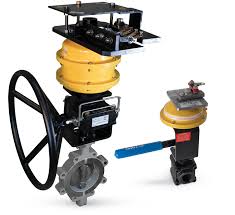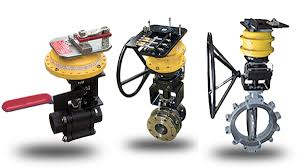Fire Safety Shut-off Valve

The Application of Fire Safety Shut-off Valve
Introducing the Fire Safety Shut-off Valve, a critical component in fire safety systems. Also known as fire safety gas shut off valve or fire safety valve for oxygen, it swiftly shuts off gas or oxygen flow during emergencies to prevent combustion. Cameron, a trusted brand, offers premium Fire Safety Shut-off Valves, ensuring reliable operation in critical situations. Used in various industries, these valves play a crucial role in safeguarding lives and properties. Trust Cameron for superior fire safety solutions tailored to your needs.
What Are The Types Of Fire Safety Shut-off Valve?
- Gas Shut-Off Valve: Designed to automatically shut off the flow of gas in case of fire emergencies, preventing potential gas leaks or explosions.
- Oxygen Shut-Off Valve: Specifically engineered for oxygen systems, these valves ensure the safe shutdown of oxygen flow during fire emergencies to prevent combustion.
- Electrically Actuated Valve: Some Fire Safety Shut-off Valves are equipped with an electrical actuator that responds to fire detection systems, providing automatic shut-off capabilities.
- Manual Reset Valve: While most Fire Safety Shut-off Valves automatically reset after activation, some models require manual intervention to reset, providing additional control.
- High-Pressure Valve: These valves are designed to withstand high-pressure environments commonly found in industrial settings, ensuring reliable shut-off in demanding conditions.
- Low-Pressure Valve: Tailored for use in low-pressure systems, these valves provide effective fire safety solutions in less demanding environments.
What Is Fire Safety Shut-off Valve?
A Fire Safety Shut-off Valve is a crucial component of fire safety systems designed to swiftly shut off the flow of gas or oxygen during emergencies. These valves, also known as fire safety gas shut off valves or fire safety valves for oxygen, activate automatically upon detecting fire, preventing potential combustion or explosions. Essential in industries where flammable gases or oxygen are present, these valves play a vital role in minimizing risks and ensuring safety in critical situations.
How to Select the Right Fire Safety Shut-off Valve?
To select the right Fire Safety Shut-off Valve, consider factors such as the type of gas or oxygen being used, pressure rating, temperature range, and compatibility with existing fire safety systems. Additionally, ensure the valve meets relevant safety standards and regulations. Consulting with experts and reputable manufacturers like Cameron can help in making an informed decision tailored to specific application requirements.
Features of Fire Safety Shut-off Valve
- Automatic Activation: Fire Safety Shut-off Valves feature automatic activation mechanisms that respond swiftly to fire emergencies, ensuring immediate shut-off of gas or oxygen flow.
- Reliable Performance: Engineered for dependable operation, these valves provide consistent performance in critical situations, minimizing risks and damages.
- Compatibility: Designed to be compatible with various gases and oxygen systems, offering versatility in application.
- High-Pressure Rating: Many Fire Safety Shut-off Valves are capable of withstanding high pressures, making them suitable for use in industrial environments.
- Temperature Sensitivity: These valves are designed to activate at specific temperature thresholds, ensuring reliable operation in high-temperature environments.
- Easy Installation: Featuring straightforward installation procedures, Fire Safety Shut-off Valves can be easily integrated into existing fire safety systems.
- Low Maintenance: With minimal maintenance requirements, these valves offer long-term reliability and cost-effectiveness.
- Compliance with Standards: Manufactured to meet stringent safety standards and regulations, ensuring adherence to industry guidelines.
Advantages and Disadvantages of Fire Safety Shut-off Valve
Advantages
- Immediate Response: Fire Safety Shut-off Valves offer immediate shut-off of gas or oxygen flow in case of fire emergencies, minimizing risks of combustion or explosions.
- Automatic Activation: These valves feature automatic activation mechanisms, eliminating the need for manual intervention and ensuring rapid response during critical situations.
- Enhanced Safety: By swiftly shutting off the flow of flammable gases or oxygen, Fire Safety Shut-off Valves help prevent potential hazards and protect lives and properties.
Disadvantages
- Limited Application: Fire Safety Shut-off Valves are primarily designed for specific applications involving flammable gases or oxygen, limiting their utility in other scenarios.
- Potential Malfunction: Like any mechanical device, there is a risk of malfunction or failure in Fire Safety Shut-off Valves, which could compromise their effectiveness during emergencies.
- Maintenance Requirements: While generally low, these valves still require periodic maintenance to ensure proper functioning, adding to operational costs and efforts.

The Specifications of Fire Safety Shut-off Valve
| Specification | Details |
|---|---|
| Type | Fire Safety Shut-off Valve |
| Ball Material | Stainless Steel or Brass |
| Attachment Type | Flanged or Threaded |
| Thread Standard | ANSI, DIN, JIS, or others |
| Thread Size | 1/2 inch to 12 inches |
| Body Material | Cast Iron, Ductile Iron, Carbon Steel, Stainless Steel, or others |
| Safe for Use With | Flammable Gases, Oxygen, or Specific Chemicals |
| Handle Type | Lever, Gear, or Actuator |
| Handle Material | Carbon Steel, Stainless Steel, or Aluminum |
| Maximum Working Pressure (psi) | Up to 1500 psi |
| Maximum Working Pressure (bar) | Up to 103.42 bar |
| Operating Pressure | Typically 0-300 psi (0-20.68 bar) |
The Installation Steps for Fire Safety Shut-off Valve
- Prepare Work Area: Clear the area around the installation site to ensure easy access to the piping system.
- Shut Off Supply: Turn off the main supply of gas or oxygen to the system where the valve will be installed.
- Relieve Pressure: If applicable, relieve any pressure in the system by opening nearby valves or faucets.
- Select Proper Location: Choose the appropriate location for installing the valve, ensuring it is easily accessible and in line with safety regulations.
- Prepare Pipes: Clean and deburr the ends of the pipes where the valve will be connected to ensure a proper seal.
- Apply Thread Sealant: Apply thread sealant or tape to the male threads of the valve to prevent leaks.
- Attach Valve: Securely attach the Fire Safety Shut-off Valve to the pipes using the appropriate attachment type (flanged or threaded), ensuring a tight connection.
- Position Valve: Ensure the valve is positioned correctly with the flow direction indicated by the arrow on the valve body.
- Tighten Connections: Use a wrench to tighten the valve connections securely, but avoid over-tightening to prevent damage.
- Check Alignment: Verify that the valve is aligned properly with the piping system to prevent stress or strain on the connections.
- Turn On Supply: Gradually turn on the main supply of gas or oxygen and check for any leaks at the valve connections.
- Test Operation: Test the valve by activating it manually or simulating a fire emergency to ensure proper shut-off and functionality.
The Operation Theory of Fire Safety Shut-off Valve
- Automatic Activation: Fire Safety Shut-off Valves are equipped with automatic activation mechanisms, such as fire safety valve fusible link, that respond to elevated temperatures, fire alarms, or other fire detection systems.
- Fusible Link: Some Fire Safety Shut-off Valves utilize a fusible link mechanism, which consists of a heat-sensitive link that melts at high temperatures. When the link melts, it triggers the valve to shut off the flow of gas or oil.
- Emergency Response: Upon activation, the valve swiftly closes, interrupting the flow of flammable gases or oil. This rapid response helps prevent fueling the fire, minimizing risks of combustion or explosions.
- Safety Features: Fire Safety Shut-off Valves often incorporate additional safety features, such as manual overrides or fail-safe mechanisms, to ensure reliable operation in emergency situations.
- Application in Oil Systems: In the context of fire safety valve oil systems, these valves play a crucial role in shutting off the flow of oil to prevent fires or mitigate the spread of flames in oil handling facilities or pipelines.
- Critical Function: Fire Safety Shut-off Valves are essential components of fire safety systems, providing vital protection for personnel, equipment, and facilities against fire hazards.
- Reliability: Designed for robustness and reliability, these valves undergo rigorous testing to ensure consistent performance in demanding environments and emergency scenarios.
